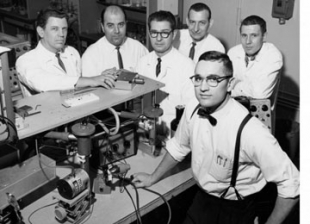Ikea announced earlier this month that it will switch to selling only LED bulbs and lamps by 2016, becoming the first U.S. home furnishing retailer to do so.
The announcement is fitting, as LED lighting technology celebrates its 50th anniversary. In October 1962, a scientist at General Electric, Nick Holonyak, invented the first practical visible-spectrum light-emitting diode, commonly known as LED.

"Boy, those were the golden years," Holonyak, now 83 years old, said in a statement. "When I went in, I didn't realize all that we were going to do. As far as I am concerned, the modern LED starts at GE."
But the real golden years for LED are just getting started. The past half-century has been a long, slow march for the lighting, which can consume up to 85 percent less energy than incandescent bulbs and can last twenty times longer.
"It's been a long period of time but the acceleration of LED has really taken shape in the last five to eight years," said John Strainic, head of consumer lighting business at GE Lighting. "We've moved from basic lighting systems like traffic signals to signage applications to refrigeration displays then into outdoor lighting."
Currently, indoor lighting is still primarily commercial applications, rather than residential lighting. Strainic said, however, that the commercial indoor space, rather than parking lot or warehouse lighting, is moving even faster than many in the industry would have thought even one or two years ago. He credits the expanding market to efficiencies and dropping prices, as well as "application-ready systems."
It is the next five years, however, where things could really get interesting. Groom Energy and GTM Research predict that the LED enterprise lighting market will surpass $1 billion in annual revenue by 2014.
In his own office, Strainic said that an LED retrofit gave the room a more evenly distributed light and controllability that were not possible with fluorescents. Although controls are one of the inherent benefits of LEDs, "I think there's a long way to go in terms of controllability," said Strainic.
There is no word from Ikea if the move to all-LEDs will also come with selling wireless controls platforms for the LEDs, like the one just announced by GreenWave Reality.
Even without controls, when a large global retailer like Ikea commits to LEDs, it will help drive down the price to a point where consumers are more apt to make the switch. "LED is a light revolution. With household electricity bills continuing to rise rapidly and global energy consumption increasing, a small LED bulb can have a very big impact. It uses much less energy than a traditional bulb and brings a lot of home furnishing potential to the home. Building on our belief that everyone should be able to afford to live more sustainably at home, we will make sure our LED prices are the lowest on the market," Steve Howard, Chief Sustainability Officer, Ikea Group, said in a statement. There was no detail of just how low those prices would be.
Groom Energy and GTM Research found that LED fixture prices have fallen 24 percent in the past two years, and the prices will continue to come down. For Ikea, it was price but also the maturation of the technology that sealed the deal to go all-LED. "It's not just about energy-efficiency; it's the whole functionality from color temperature through to strength and durability," Howard said during a teleconference earlier this month. The company will also go all-LED in its stores, factories and distribution centers, according to Bloomberg.
It is the value-add of LEDs that is harder to quantify but could become an important driver in the commercial and residential market once people get to know them. "There's real value in terms of employee morale," Strainic said of LEDs that can be dimmed based on daylight harvesting or tailored to personal preferences.
For stores like Ikea, LEDs can change color to alter the look or feel of the entire store or certain displays. GE recently announced a partnership with USG Logix ceiling system to build LEDs directly into the ceiling. Redwood Systems, a startup that networks LEDs and other lighting systems, said that by year's end it would deliver a "Room Tracker" tool to manage conference rooms, all running over the same network and control platform that it uses to manage the lights. For startups and lighting incumbents, new partnerships will become key to deliver LEDs to the masses.
In the next ten years, rethinking lighting design will also start to trickle down to the residential market, Strainic hypothesized. "It's a challenge to change traditional design approaches," he said. Strainic envisioned a channel of light, rather than individual cans, in a great room of a home, that could allow architects to hide the lighting source while still providing ambient illumination. Networked lights at home can also serve as part of a home security system with timer settings that could be tweaked from a smart phone.
"We're just getting started," said Strainic. "There's still a long way to go."





